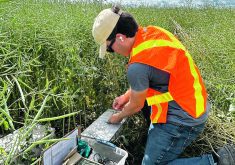Soil-borne disease tough to control | Stagger crop rotations with cereals to combat disease
As a consistent high profit generator, canola-seeded area has doubled in the past 10 years, mostly by reducing rotations from once every three or four years to once every other year or continuous.
However, short rotations encourage development of fungi and weeds able to overcome disease resistance in crops and herbicides. With the right weather circumstances last summer, many farmers saw crop disease severely limit yield.
Western Producer reporters Robert Arnason, Barb Glen and Robin Booker have compiled this special report looking at how canola’s success encourages pests that threaten its future.
Read Also

Phosphate prices to remain high
Phosphate prices are expected to remain elevated, according to Mosaic’s president.
It’s about pick-up trucks, in a way. Farmers in Alberta are similar to their counterparts in Saskatchewan and Manitoba in favouring a rotation of canola-cereal-canola as their preferred cropping plan. And that’s because of economics.
“Some farmers tell me it’s $100 more (per acre) easy, on average, with canola. On two quarters, that’s a pick-up truck,” says Alberta Agriculture oilseed specialist Murray Hartman.
“I can’t blame them, but on the other hand I think they have to be prepared to maybe lose money in the future by taking more money now. That’s a possibility.”
Hartman said today’s farmers put less emphasis on crop rotation than they did 25 years ago, when maintaining a three to four year rotation was commonplace. That was before canola was rampant and profits from the oilseed far exceeded those earned for cereal crops.
Some farmers say they are comfortable pushing rotations because they have confidence research will find ways to beat the increased disease and insect pressure that canola on canola or two-year rotations can bring.
“I just hope these are the people that don’t ask for a refund on their levies so they can support the research,” said Hartman.
“Basically, federal and provincial research dollars are shrinking, so industry has to drive it.”
Hartman isn’t confident science will provide the answers to disease and insect issues by the time producers need them. Blackleg prevalence appears to be increasing across the Prairies, while clubroot has taken hold in central Alberta and was found in Saskatchewan last year.
“If you’ve got canola everywhere, even if you’re controlling all your current pests, you’re still leaving a niche at the buffet for something else to come in,” said Hartman.
“Even if we can handle what we got, it still makes a bigger risk for something new to come in. Clubroot is a good example, where it has spread a lot more rapidly than it would have if everybody would have been in a one in four (rotation).”
Clubroot, a disease that affects the roots of canola plants and reduces crop yield and quality, was first found in Alberta canola in 2003. It has since spread to more than 17 municipalities in Alberta and has also been found in southern Saskatchewan.
The soil-borne disease is spread by spores and is difficult to control. In 2007, Alberta implemented a clubroot control plan.
“Resting spore longevity is a key factor contributing to the seriousness of the clubroot disease, especially under short crop rotations,” the plan reads.
Crop rotations of four and sometimes five years are now enforced in Alberta municipalities where clubroot has been found.
Blackleg, another disease-limiting crop disease, is also related to short rotations.
Ralph Lange, who leads a program for feedstock development at Alberta Innovates, said incidence of the disease in the province is at least 80 percent and probably higher.
His studies show more blackleg in Alberta compared to Saskatchewan and Manitoba, but he said that may be due to better identification of the disease, which can be difficult to determine without looking at canola plant cores.
In any case, Lange said rotation is a factor in blackleg infection.
“Shorting the rotations definitely increases the opportunities for the fungus,” he said.
“It just reduces the distance between fields, for example. It also gives many more opportunities for the blackleg fungus to adapt to the resistance genetics that breeders have thrown at it. So yeah, short rotation really contributes to the evolution of the organism.”
Lange said canola varieties resistant to blackleg have curbed problems, but the disease is capable of evolving different races and overcoming existing resistant varieties.
“The challenge of the canola industry, right from the growers to the breeders to everyone, is stewarding the resistance genetics that we have,” said Lange.
“Really, it boils down to presenting that fungus in the environment with different genes in each field in different years.”
He foresees a future in which canola growers will have to use resistant varieties in combination with fungicides to keep blackleg under control.
Putting canola in a longer rotation with non-host crops would also help.
There’s a prescription that will encourage producers to use longer rotations, but it is a difficult one to fill, said Hartman.
“The cure for this would be good returns in wheat and barley. In fact, if you could get the same amount of money, net return on wheat and barley, canola acres would probably be a third of what they are now because it’s a harder crop to grow.”















